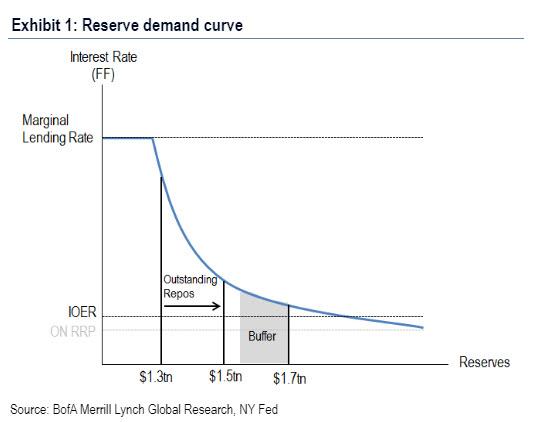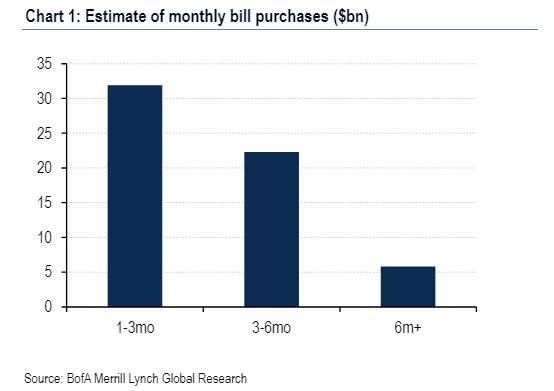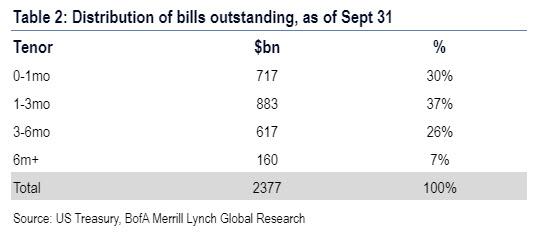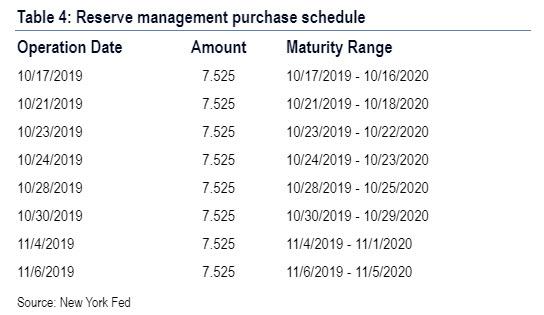As it pre-announced last Friday, the Fed will resume QE by purchasing $60billion/month in bills at least until 2Q 2020 starting on October 17. As has been widely discussed, and mocked, already, the Fed highlighted that these purchases were for reserve management only and have "no material implications for the stance of monetary policy", although how a restoration of financial conditions hit during the greater monetary policy experiment in history is not seen as, well, monetary policy is ludicrous.
"QE or Not QE" debate aside (here is Bloomberg opining on which is which), the Fed stated that by the time purchases conclude the level of reserves should be in line with early September levels. In addition, overnight and term repo operations will continue at least through January of next year and are specifically intended to manage funding pressures on a daily basis. As Bank of America noted overnight, this action represents a necessary step that serves "to fix the reserve hole the Fed dug itself into by continuing QT for too long", because apparently shrinking the balance sheet by $600BN after it was blown out by $4 trillion nearly crashed the banking system. This will also place the Fed back into an "abundant reserve regime", and represents a rapid shift away from repo operations to permanent balance sheet growth. Finally, it is also a confirmation that the Fed shares the prevailing view that funding pressures were driven by "reserve scarcity" vs "reserve distribution" issues (which were first suggested by the NY Fed's clueless president, John Williams).
As BofA's Marc Cabana writes, Fed purchases could total more than $400bn by mid-2020, and bring the level of reserves in the system close to $1.7tn, something we noted last week. This will allow the Fed to convert all existing repo operations into permanent balance sheet growth while also allowing them to build a reserve "buffer" to move comfortably away from the upward sloping part of the reserve demand curve.
As a reminder, reserves were at $1.45tn in the week before funding pressures spiked and the Fed could potentially flex the amount of purchases higher or lower (spoiler alert: higher) over time depending on prevailing market conditions. This substantial reserve increase reduces the need for a standing repo facility in the near term, and provides the Fed time to work out details of that facility which BofA believes will be announced by end-2020, which will eventually act as an "automatic stabilizer" to increase reserves whenever they become too low and prevent another large jump up the upward sloping part of the reserve demand curve.
Which brings us to the main question: what will the Fed buy?
BofA anticipates purchases will be distributed in proportion to bills outstanding, as shown below.
However, the Fed has stated it cannot purchase securities with 4 weeks or less to maturity, which make up 30% of T-bills outstanding.
To allow itself additional flexibility, the Fed left the size of purchases open ended, with $60BN per month the "initial pace," but only discussed bills in the context of reserve management. The Fed could expand purchases into short coupons in the coming months, while BofA also sees a "risk" that Treasury increases bill issuance next year, which would reduce the need to grow coupon auction sizes to offset the growing deficit.
What happens next?
The Fed's program of bill purchases should be successful in increasing reserves outstanding and richening front end USTs, according to Cabana, however, if Fed purchases prove too aggressive and end up displacing MMF out of bills...
... and into repo or other front end assets, the overall structure of money market rates could materially fall.
As a result, a distinct risk is that money market rates fall too far and end up pushing MMF into the ON RRP. If MMF re-allocate away from bills into the ON RRP this would mechanically serve as a reserve drain and be counterproductive from the Fed's perspective. As a simplified example, if the Fed buys $1 of bills from MMF and the MMF invest that $1 into RRP, then reserves would remain constant. In this example, the Fed's balance sheet would increase $1 and MMF portfolio size would remain unchanged. To offset this dynamic the Fed might need to either lower ON RRP or increase IOER in relation to ON RRP. To help mitigate the risk of MMF inflow into ON RRP and a mechanical reserve drain the Fed will probably consider targeting purchases into short coupon securities outside of the MMF investable universe (397 days).
Some additional operational details:
Bill purchases will start on Oct 17 and then occur on Mondays and Wednesdays going forward.
As holdings mature, they will be rolled over at auction into new Treasury bill securities. The NY Fed will not purchase securities with less than 4 weeks to maturity or cash management bills. Only primary dealers can purchase. The Fed can only buy securities in the open market, which eliminates the possibility of using auction add-ons to build the reserve balances. As for the recently relaunched repo operations, these will continue at least through Jan 2020: overnight operations conducted daily, at least $75bn in size, term operations conducted twice per week, at least $35bn in size.





Nessun commento:
Posta un commento